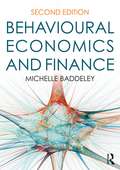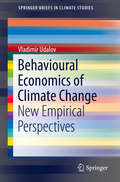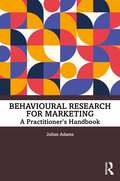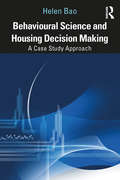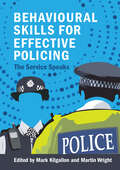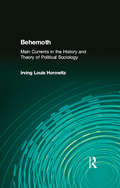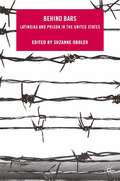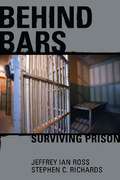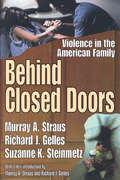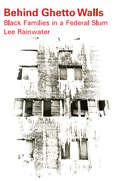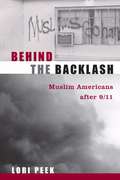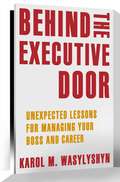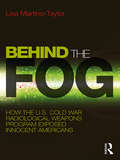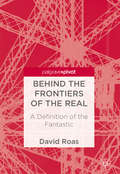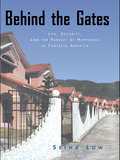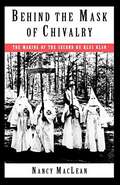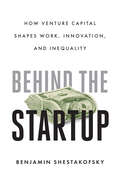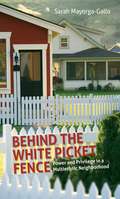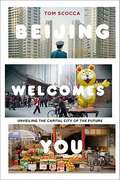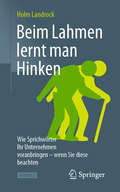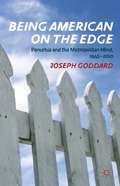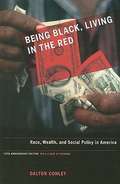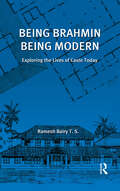- Table View
- List View
Behavioural Economics and Finance (Routledge Advanced Texts In Economics And Finance Ser.)
by Michelle BaddeleyBehavioural economics and behavioural finance are rapidly expanding fields that are continually growing in prominence. While orthodox economic models are built upon restrictive and simplifying assumptions about rational choice and efficient markets, behavioural economics offers a robust alternative using insights and evidence that rest more easily with our understanding of how real people think, choose and decide. This insightful textbook introduces the key concepts from this rich, interdisciplinary approach to real-world decision-making. This new edition of Behavioural Economics and Finance is a thorough extension of the first edition, including updates to the key chapters on prospect theory; heuristics and bias; time and planning; sociality and identity; bad habits; personality, moods and emotions; behavioural macroeconomics; and well-being and happiness. It also includes a number of new chapters dedicated to the themes of incentives and motivations, behavioural public policy and emotional trading. Using pedagogical features such as chapter summaries and revision questions to enhance reader engagement, this text successfully blends economic theories with cutting-edge multidisciplinary insights. This second edition will be indispensable to anyone interested in how behavioural economics and finance can inform our understanding of consumers’ and businesses’ decisions and choices. It will appeal especially to undergraduate and graduate students but also to academic researchers, public policy-makers and anyone interested in deepening their understanding of how economics, psychology and sociology interact in driving our everyday decision-making.
Behavioural Economics of Climate Change: New Empirical Perspectives (Springerbriefs In Climate Studies)
by Vladimir UdalovThis book investigates various kinds of climate change mitigation behaviour, which range from a general support of environmental policy to concrete energy-saving activities, in selected countries. Drawing on extensive national and international survey data, the analysis has the following main objectives: to identify potential determinants of individuals’ renewable energy support, and to analyse the impact of experiences with natural disasters on individuals’ choice between economic growth and environmental protection. Moreover, it examines the role of environmental motivations behind direct daily energy-saving behaviour. The empirical results reveal that various types of climate change mitigation behaviour are not only driven by a mixture of environmental and non-environmental/economic motivations but also depend on external circumstances such as natural disasters. Since CO2 emission dynamics stem to some extent from the choices people make every day in their roles as consumers, investors and citizens, the new findings presented are also valuable from a policy perspective.
Behavioural Research for Marketing: A Practitioner's Handbook
by Julian AdamsThis book, the first of its kind, provides market researchers and marketeers with the tools to better understand human behaviour by drawing upon social science theory from different schools of thought, including sociology, psychology and behavioural economics. It has practical examples throughout to help illustrate how to operationalise theory in market research and to underpin the way we understand how people think, behave, decide and make choices. Each theory is explained in accessible terms to ensure that the content is relevant and useful to commercial market researchers. By considering different theoretical models of human behaviour from the outset, this book will open new avenues of investigation, help researchers to develop more dynamic and challenging hypotheses to test during the research process, and ultimately result in more insightful outcomes. The book brings together theories that look at how society is shaped and formed, and how this impacts on the individual, along with theories that focus on the mind and behaviour of the individual; these perspectives are equally important in market research but not usually considered within the same text. This book is not limited to theory alone; in each chapter, illustrative examples are used to help demonstrate how theory can be applied to real-world market research projects. Additionally, throughout there are helpful suggestions in terms of question content to help operationalise theory. This book will appeal to those that have recently entered the field of market research and are interested in the theoretical underpinnings of human behaviour, undergraduates and post-graduates that are studying marketing, business studies or social science, where a core component of the course requirement is market research, and finally those that are users of market research data and want a working knowledge of key theories of human behaviour.
Behavioural Science and Housing Decision Making: A Case Study Approach
by Helen BaoThis book takes a behavioural approach to examine six important housing questions: tenure decision, gentrification, place attachment, housing bubbles, housing wealth, and residential satisfaction. Using experimental and field data, the book demonstrates the effects of six behavioural biases and heuristics (i.e., anchoring and reference dependence, loss aversion, mental accounting, endowment effect, herd behaviours, and social comparison) on these housing decisions. The first part of the book introduces the questions and provides a behavioural science toolbox before the second part adopts a real-world case study approach. Real data sets and suggested answers are provided, and the cases come from the UK, USA, and China. Background information is given in each case to facilitate the understanding of the case data and question, as well as the discussions on the results. This book is ideal supplementary reading on a variety of courses such as housing studies, economics, real estate, research methods, and for students and academics who are interested in the application of behavioural science in housing decisions.
Behavioural Skills for Effective Policing: The Service Speaks
by Martin Wright Mark KilgallonBehavioural skills are essential to effective policing practice and professional development, and are also embedded within the policing competency frameworks. As the police service looks to further redefine its role in the twenty-first century, this critical handbook covers the full range of these proficiencies, from building rapport, applying emotional intelligence, building empathy and resilience to diversity and difference, understanding ethics, and developing coaching and leadership skills.Each chapter is written by a distinguished serving or former senior police leader and/or policing scholar, bringing together a wealth of experience and understanding and applying this knowledge in context through key case studies and examples. Suitable for serving police officers at all levels, as well as policing lecturers and students aspiring to join the police, this book encourages and enables a people-centred approach to policing that balances the debate that has given disproportionate credence to transactional skills at the expense of a more transformational approach.
Behemoth: Main Currents in the History and Theory of Political Sociology
by Irving HorowitzThe title, Behemoth, derives from the Hebrew word Behemah-a beast, an enormous creature, monstrously huge and vast. It is an apt description of the State on the eve of the twenty-first century. Loved by few, vilified by many from all perspectives, it nonetheless continues to grow; by turns rivaling and co-opting that more pleasant-sounding word: Society. Political sociology aims to define and understand the interrelationship between these two huge terms: State and Society.Continuing in a path begun by Horowitz in the 1950s in The Idea of War and Peace in Contemporary Social and Philosophical Thought, expanded upon in the 1970s with Foundations of Political Sociology, this summing up in the late 1990s is an effort to extract and evolve the canon of political sociology. Starting with Montesquieu, Horowitz proceeds through the European experience of Rousseau, Tocqueville, Hegel, Marx, Durkheim, Sorel, and Weber. He then takes the field on its tangled migration to America with the Frankfurt School in exile, followed by searching chapters on Schumpeter, Mills, Arendt, and Huntington, among others.The result is a stunning revaluation of the intellectual sources of the present day divisions between statists and socialists, welfarists and individualists, advocates of dictatorship and of democracy, mandated rules and voluntary association, hard realists and soft utopians, a world without states and a world with a single state. Horowitz does not offer the usual evolutionary notion of doctrines, but a canon embedded in and embattled with the societies they aim to serve or overthrow in the present as in the past. The result is a major recasting of the theory and practice of social science and normative frameworks.The final chapter offers Horowitz's own prognosis of what we can expect in the recasting of the Welfare State to include the Welfare Society, and its growing nemesis the global economy which threatens to engulf State and Society alike in a return to civilizational concerns. This is an essential text for policy-makers and social scientists interested in macroscopic changes in the political order.
Behind Bars: Latino/as and Prison in the United States
by Suzanne ObolerThis book addresses the complex issue of incarceration of Latino/as and offers a comprehensive overview of such topics as deportations in historical context, a case study of latino/a resistance to prisons in the 70s, the issues of youth and and girls prisons, and the post incarceration experience.
Behind Bars: Surviving Prison
by Jeffrey Ian Ross Stephen C. RichardsThis book explains the process leading up to prison and the experiences of what happens there.
Behind Closed Doors: Violence in the American Family
by Suzanne K. Steinmetz Richard J. Gelles Murray A. StrausThe marriage license as a hitting license, child abuse, sibling war is the powerful message of "Behind Closed Doors". The book is grounded in the unprecedented national survey of the extent, patterns, and causes of violence in the American family. Based on a seven-year study of over 2,000 families, the authors provide landmark insights into this phenomenon of violence and what causes Americans to inflict it on their family members. The authors explore the relationship between spousal abuse and child abuse as well as abuse between siblings, violence by children against their parents, and the causes and effects of verbal abuse. Taken together, their analysis provides a vivid picture of how violence is woven into the fabric of family life and why the hallmark of family life is both love and violence. This is a comprehensive, highly readable account of interest to both the professional and the lay-person on an important topic, which concerns the social well-being of us all.
Behind Ghetto Walls: Black Families in a Federal Slum
by Michael NovakThis book is about the family lives of some 10,000 children and adults who live in an all-Negro public housing project in St Louis. The Pruitt-Igoe project is only one of the many environments in which urban Negro Americans lived in the 1960s, but the character of the family life there shares much with the family life of lower-class Negroes as it has been described by other investigators in other cities and at other times, in Harlem, Chicago, New Orleans, or Washington D.C. This book is primarily concerned with private life as it is lived from day to day in a federally built and supported slum. The questions, which are treated here, have to do with the kinds of interpersonal relationships that develop in nuclear families, the socialization processes that operate in families as children grow up in a slum environment, the informal relationships of children and adolescents and adults with each other, and, finally, the world views (the existential framework) arising from the life experiences of the Pruitt-Igoeans and the ways they make use of this framework to order their experiences and make sense out of them. The lives of these persons are examined in terms of life cycles. Each child there is born into a constricted world, the world of lower class, Negro existence, and as he grows he is shaped and directed by that existence through the day-to-day experiences and relationships available to him. The crucial transition from child of a family; to progenitor of a new family begins in adolescence, and for this reason the book pays particular attention to how each new generation of parents expresses the cultural and social structural forces that formed it and continue to constrain its behavior. This book, in short, is about intimate personal life in a particular ghetto setting. It does not analyze the larger institutional, social structural, and ideological forces that provide the social, economic, and political context in which lower-class Negro life is lived. These larger macro sociological forces are treated in another volume based on research in the Pruitt-Igoe community. However, this book does draw on the large body of literature on the structural position of Negroes in American society as background for its analysis of Pruitt-Igoe private life.
Behind the Backlash: Muslim Americans after 9/11
by Lori PeekAs America tried to absorb the shock of the 9/11 attacks, Muslim Americans were caught up in an unprecedented wave of backlash violence. Public discussion revealed that widespread misunderstanding and misrepresentation of Islam persisted, despite the striking diversity of the Muslim community. Letting the voices of 140 ordinary Muslim American men and women describe their experiences, Lori Peek's path-breaking book, Behind the Backlash, presents moving accounts of prejudice and exclusion. Muslims speak of being subjected to harassment before the attacks, and recount the discrimination they encountered afterwards. Peek also explains the struggles of young Muslim adults to solidify their community and define their identity during a time of national crisis. Behind the Backlash seeks to explain why blame and scape-goating occur after a catastrophe. Peek sets the twenty-first century experience of Muslim Americans, who were vilified and victimized, in the context of larger sociological and psychological processes. Peek's book will be of interest to those in disaster research studies, sociology of religion, and race and ethnic relations.
Behind the Eight Ball: Sex for Crack Cocaine Exchange and Poor Black Women
by Tanya Telfair SharpeInner-city black women open their hearts to share the pain of crack addiction and its consequences Behind the Eight Ball: Sex for Crack Cocaine Exchange and Poor Black Women documents an American tragedy that highlights the widening gap between social and economic classes. In their own words, poor black women-nameless, faceless, and marginalized by poverty-share the details of their lives before and after crack cocaine invaded their communities, each recalling the circumstances of her introduction to the drug and her first experience using sex to support her addiction. These candid interviews expose the socioeconomic changes in inner-city neighborhoods that created the perfect conditions for a crack stronghold; the crack cocaine economy's impact on the lives of inner-city residents; and the social and familial consequences of crack addiction among poor, black women. Behind the Eight Ball: Sex for Crack Cocaine Exchange and Poor Black Women places crack addiction, crack-related prostitution and its consequences, STDs, HIV, and pregnancy into the context of the larger social issues of inner-city poverty, race, gender, and class. This unique book reveals the sex-for-crack barter system as evidence of a long-term social exclusion and systemic racism that has worked to destroy the self-image of poor black American women. The women interviewed reflect this negative image, exchanging sex for crack on a regular basis to support their addictions at the risk-and reality-of unplanned pregnancies. "The baby I am carrying now, I don&’t know who the father is. There are a few (men) that I had sex with around the time I got pregnant-that day. But which one it is, I don&’t know who."Behind the Eight Ball: Sex for Crack Cocaine Exchange and Poor Black Women examines: why poor black women addicted to crack are disproportionately at risk for sexually transmitted diseases, including HIV, and unplanned pregnancies how the social and economic characteristics of poor black communities support crack distribution and consumption how crack use and the exchange of sex for crack damages struggling black families why the care of many children is entrusted to child welfare agencies how and why women are marginalized in the crack cultureBehind the Eight Ball: Sex for Crack Cocaine Exchange and Poor Black Women is an insightful and enlightening look at the motivations behind the decision to risk illness, injury, disease, death, and pregnancy to support addiction.
Behind the Executive Door: Unexpected Lessons for Managing Your Boss and Career
by Karol M. WasylyshynSigmund Freud meets Peter Drucker ... Behind the Executive Door is a revealing look at the behavior of top business leaders--and how the next level of aspiring managers can learn to navigate the political and personal landscape. Based on over 25 years of psychotherapy and consulting experiences, as well as extensive empirical research, Karol Wasylyshyn has identified a dynamic continuum of executive behaviors that are manifested in three specific types of business leaders - Remarkable, Perilous, and Toxic. She describes these types in accessible terms with the intertwined goals of helping readers (1) recognize these behaviors and leadership types and (2) leverage this information to increase their savvy and effectiveness in the workplace. In the wake of Sarbanes-Oxley and the increased scrutiny of business executives, we have learned that how they lead is often their undoing - or at least it is a pressing development need and/or potential derailment factor. In short, despite financial or strategic smarts, ineffective leadership behavior de-motivates talented employees, has adverse effects on productivity, and jeopardizes positive business results. Conversely, we can recognize the qualities of effective leadership behavior, which is largely a function of emotional intelligence, the ability to tap into the needs and motivations of others and bring out their best performance. In Behind the Executive Door, the author provides a wide variety of tools and exercises to help the reader identify the behavior traits of their organizations' leaders -and hone their own approaches to achieve positive results. In the process, readers will also gain insights and skills to manage laterally and down, as well as up the organizational ladder. The concepts can be applied in any type of organization - private or public, for-profit or non-profit. The result is not only a better understanding of organizational politics and leadership behavior, but a practical guide to making important career decisions, such as whom to work for and how to develop one's own leadership style.
Behind the Fog: How the U.S. Cold War Radiological Weapons Program Exposed Innocent Americans
by Lisa Martino-TaylorBehind the Fog is the first in-depth, comprehensive examination of the United States’ Cold War radiological weapons program. The book examines controversial military-sponsored studies and field trials using radioactive "simulants" that exposed American civilians to radiation and other hazardous substances without their knowledge or consent during the Cold War. Although Western biological and chemical weapons programs have been analyzed by a number of scholars, Behind the Fog is a strong departure from the rest in that the United States radiological weapons program has been generally unknown to the public. Martino-Taylor documents the coordinated efforts of a small group of military scientists who advanced a four-pronged secret program of human-subject radiation studies that targeted unsuspecting Americans for Cold War military purposes. Officials enabled such projects to advance through the layering of secrecy, by embedding classified studies in other studies, and through outright deception. Agency and academic partnerships advanced, supported, and concealed the studies from the public at large who ultimately served as unwitting test subjects. Martino-Taylor’s comprehensive research illuminates a dark chapter of government secrecy, the military-industrial-academic complex, and large-scale organizational deviance in American history. In its critical approach, Behind the Fog effectively examines the mechanisms that allow large-scale elite deviance to take place in modern society.
Behind the Frontiers of the Real: A Definition of the Fantastic
by David RoasThis book offers a definition of the fantastic that establishes it as a discourse in constant intertextual relation with the construct of reality. In establishing the definition of the fantastic, leading scholar David Roas selects four central concepts that allow him to chart a fairly clear map of this terrain: reality, the impossible, fear, and language. These four concepts underscore the fundamental issues and problems that articulate any theoretical reflection on the fantastic: its necessary relationship to an idea of the real, its limits, its emotional and psychological effects on the receiver and the transgression of language that is undertaken when attempting to express what is, by definition, inexpressible as it is beyond the realms of the conceivable. By examining such concepts, the book explores multiple perspectives that are clearly interrelated: from literary and comparative theory to linguistics, via philosophy, science and cyberculture.
Behind the Gates: Life, Security, and the Pursuit of Happiness in Fortress America
by Setha LowFirst Published in 2003. Routledge is an imprint of Taylor & Francis, an informa company.
Behind the Mask of Chivalry: The Making of the Second Ku Klux Klan
by Nancy K. MacLeanOn Thanksgiving night, 1915, a small band of hooded men gathered atop Stone Mountain, an imposing granite butte just outside Atlanta. With a flag fluttering in the wind beside them, a Bible open to the twelfth chapter of Romans, and a flaming cross to light the night sky above, William Joseph Simmons and his disciples proclaimed themselves the new Knights of the Ku Klux Klan, named for the infamous secret order in which many of their fathers had served after the Civil War. Unsure of their footing in the New South and longing for the provincial, patriarchal world of the past, the men of the second Klan saw themselves as an army in training for a war between the races. They boasted that they had bonded into "an invisible phalanx...to stand as impregnable as a tower against every encroachment upon the white man's liberty...in the white man's country, under the white man's flag." This book brings the "invisible phalanx" into broad daylight, culling from history the names, the life stories, and the driving passions of the anonymous Klansmen beneath the white hoods and robes. Using an unusual and rich cache of internal Klan records from Athens, Georgia, to anchor her observations, author Nancy MacLean combines a fine-grained portrait of a local Klan world with a penetrating analysis of the second Klan's ideas and politics nationwide. No other right-wing movement has ever achieved as much power as the Ku Klux Klan of the 1920s, and this book shows how and why it did. MacLean reveals that the movement mobilized its millions of American followers largely through campaigns waged over issues that today would be called "family values": Prohibition violation, premarital sex, lewd movies, anxieties about women's changing roles, and worries over waning parental authority. Neither elites nor "poor white trash," most of the Klan rank and file were married, middle-aged, and middle class. Local meetings, or klonklaves, featured readings of the minutes, plans for recruitment campaigns and Klan barbecues, and distribution of educational materials--Christ and Other Klansmen was one popular tome. Nonetheless, as mundane as proceedings often were at the local level, crusades over "morals" always operated in the service of the Klan's larger agenda of virulent racial hatred and middle-class revanchism. The men who deplored sex among young people and sought to restore the power of husbands and fathers were also sworn to reclaim the "white man's country," striving to take the vote from blacks and bar immigrants. Comparing the Klan to the European fascist movements that grew out of the crucible of the first World War, MacLean maintains that the remarkable scope and frenzy of the movement reflected less on members' power within their communities than on the challenges to that power posed by African Americans, Jews, Catholics, immigrants, and white women and youth who did not obey the Klan's canon of appropriate conduct. In vigilante terror, the Klan's night riders acted out their movement's brutal determination to maintain inherited hierarchies of race, class, and gender. Compellingly readable and impeccably researched, this is an unforgettable investigation of a crucial era in American history, and the social conditions, cultural currents, and ordinary men that built this archetypal American reactionary movement.
Behind the Startup: How Venture Capital Shapes Work, Innovation, and Inequality
by Benjamin ShestakofskyThis systematic analysis of everyday life inside a tech startup dissects the logic of venture capital and its consequences for entrepreneurs, workers, and societies. In recent years, dreams about our technological future have soured as digital platforms have undermined privacy, eroded labor rights, and weakened democratic discourse. In light of the negative consequences of innovation, some blame harmful algorithms or greedy CEOs. Behind the Startup focuses instead on the role of capital and the influence of financiers. Drawing on nineteen months of participant-observation research inside a successful Silicon Valley startup, this book examines how the company was organized to meet the needs of the venture capital investors who funded it. Investors push startups to scale as quickly as possible to inflate the value of their asset. Benjamin Shestakofsky shows how these demands create organizational problems that managers solve by combining high-tech systems with low-wage human labor. With its focus on the financialization of innovation, Behind the Startup explains how the gains generated by these companies are funneled into the pockets of a small cadre of elite investors and entrepreneurs. To promote innovation that benefits the many rather than the few, Shestakofsky compellingly argues that we must focus less on fixing the technology and more on changing the financial infrastructure that supports it.
Behind the White Picket Fence
by Sarah Mayorga-GalloThe link between residential segregation and racial inequality is well established, so it would seem that greater equality would prevail in integrated neighborhoods. But as Sarah Mayorga-Gallo argues, multiethnic and mixed-income neighborhoods still harbor the signs of continued, systemic racial inequalities. Drawing on deep ethnographic and other innovative research from "Creekridge Park," a pseudonymous urban community in Durham, North Carolina, Mayorga-Gallo demonstrates that the proximity of white, African American, and Latino neighbors does not ensure equity; rather, proximity and equity are in fact subject to structural-level processes of stratification. Behind the White Picket Fence shows how contemporary understandings of diversity are not necessarily rooted in equity or justice but instead can reinforce white homeowners' race and class privilege; ultimately, good intentions and a desire for diversity alone do not challenge structural racial, social, and economic disparities. This book makes a compelling case for how power and privilege are reproduced in daily interactions and calls on readers to question commonsense understandings of space and inequality in order to better understand how race functions in multiethnic America.
Beijing - A Concise History (Routledge Studies in the Modern History of Asia #Vol. 41)
by Stephen G. HawStephen Haw sets out the history of the city of Beijing, charting the course of its development from its early roots before 2000 BC to its contemporary position as capital of the People’s Republic of China. Stephen Haw, a well-established author on China, outlines the establishment of the earliest cities in the years before 1000 BC, its status as regional capital during most of the long Zhou dynasty, and its emergence as capital of the whole of China after the conquest of the Mongol invaders under Chenghiz Khan and his successors. He considers the city’s assumption of its modern name ‘Beijing’ under the Ming dynasty, conquest by the Manchus and the turbulent years of civil war that followed the collapse of the Qing dynasty in 1911, culminating in the communist revolution and Beijing’s resumption of the role of capital of China in 1949. Overall, Stephen Haw gives an impressive account of the long and fascinating history of a city that is growing in prominence as an urban centre of global significance.
Beijing Welcomes You
by Tom ScoccaA definitive, and highly entertaining, account of contemporary Beijing, the undisputed capital of the twenty-first century. Within the past decade, Beijing has debuted as the defining city of the now and foreseeable future, and China as the ascendant global power. Beijing is the ultimate representation of China's political and cultural capital, of its might-and threat. For so long, the city was closed off to the world, literally built around the Forbidden City, the icon of all that was ominous about China. But now, the country is eager to show off its new openness, its glory and magnanimity, and Beijing is its star. When Tom Scocca arrived in 2004-an American eager to see another culture-Beijing was looking toward welcoming the world to its Olympics four years later, and preparations were in full swing to create a renewed city. Scocca talked to the scientists tasked with changing the weather; interviewed designers and architects churning out projects; checked out the campaign to stop public spitting; documented the planting of trees, the rerouting of traffic, the demolition of the old city, and the construction of the new metropolis. Beijing Welcomes You is a glimpse into the future and an encounter with an urban place we do not yet fully comprehend, and the superpower it is essential we get to know better. .
Beim Lahmen lernt man Hinken: Wie Sprichwörter Ihr Unternehmen voranbringen – wenn Sie diese beachten
by Holm LandrockEntdecken Sie in diesem Buch passende Sprichwörter und Redensarten für die UnternehmensführungIn seinem Buch „Beim Lahmen lernt man Hinken“ führt Holm Landrock mit einem Augenzwinkern und einer ganzen Menge bekannter Redensarten durch die Welt der Wirtschaft im Zeitalter der Digitalisierung. Über viele Jahrhunderte hat der Volksmund eine Unmenge von Sprichwörtern geschaffen, welche die Weisheiten der verschiedenen Epochen widerspiegeln. Wer die in diesen Sprichwörtern vermittelten Grundsätze ignoriert, wird privat wie geschäftlich scheitern. Das macht „Beim Lahmen lernt man Hinken“ zu einem amüsanten Sachbuch für alle, die Bildungsfutter und Lesespaß in einem haben möchten.Der Inhalt des Buchs über Redensarten für die Unternehmensführung im ÜberblickDas Buch „Beim Lahmen lernt man Hinken“ gibt Tipps zur Unternehmensführung am Beispiel zahlreicher Sprichwörter wie: • Schuster, bleib bei Deinem Leisten• Der Krug geht solange zum Wasser, bis er bricht• Hochmut kommt vor dem Fall• Ein Erfahrener ist besser als zehn Gelehrte• Der Teufel scheißt immer auf den größten Haufen• Beim Lahmen lernt man Hinken• Und viele weitere bekannte SprichwörterEs richtet sich nicht nur an Manager und Führungskräfte aus allen Branchen, sondern auch an interessierte Laien sowie sprachlich Interessierte aller Berufsgruppen. Darüber hinaus können sich vielleicht sogar Studierende sowie Start-ups praktische Anregungen, Ideen und Tipps für ihre Arbeit einholen.
Being American on the Edge
by Joseph GoddardThis manuscript focuses on the development of hybrid city-country (penurban) landscapes around large urban areas which mesh stylized countryside with functional links to the cities. These landscapes are central to American mindsets as they combine the dreams, expectations, and experiences of the nation in expressive cultural landscapes. An interpretive-analytical methodology is used in this single-authored, multidisciplinary work which draws on insights from history, American Studies, social sciences, urban studies, and environmental studies, and cultural studies in order to portray lifestyle and settlement phenomena overlooked by single disciplinary fields. Telling the story of how penurban landscapes emerged, the work blends original research with a re-reading of existing work to understand developing lifestyle and settlement patterns. The book aims at readers in history, urban studies, environmental studies, consumerism and American Studies.
Being Black, Living in the Red: Race, Wealth, and Social Policy in America
by Dalton ConleyBeing Black, Living in the Red demonstrates that many differences between blacks and whites stem not from race but from economic inequalities that have accumulated over the course of American history. Property ownership--as measured by net worth--reflects this legacy of economic oppression. The racial discrepancy in wealth holdings leads to advantages for whites in the form of better schools, more desirable residences, higher wages, and more opportunities to save, invest, and thereby further their economic advantages. A new afterword by the author summarizes Conley's recent research on racial differences in wealth mobility and security and discusses potential policy solutions to the racial asset gap and America's low savings rate more generally.
Being Brahmin, Being Modern: Exploring the Lives of Caste Today
by Ramesh BairyThere is clearly an academic and political obsession with the ‘idea’ of the Brahmin. There is also, simultaneously, a near-complete absence of engagement with the Brahmin as an embodied person or community. This book addresses this intriguing paradox by making available a sociological description of the Brahmins in today’s Karnataka. It pursues three distinct, yet enmeshed, registers of inquiry – the persona of the ‘Brahmin’ embodied in the agency of the individual Brahmin; the organised complexes of action such as the caste association and the public culture of print; and finally, taking off from a longer (yet, modern and contemporary) history of non-Brahminical othering of the Brahmin. It argues that we tend to understand the contemporaneity of caste almost exclusively within the twin registers of legitimation–contestation and dominance–resistance. While these facets continue to be salient, there is also a need to push out into hitherto neglected dimensions of caste. The book focuses attention on the many lives of modern caste — its secularisation, the subject positions that it offers, the equivocations by which persons and communities become ‘subjects’ of caste, their differential investments in the caste-self.
